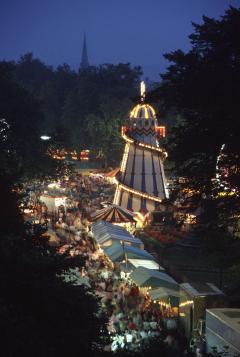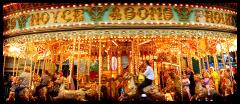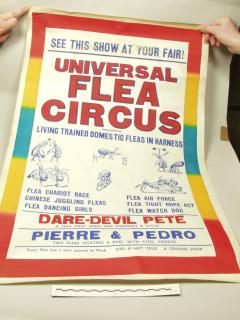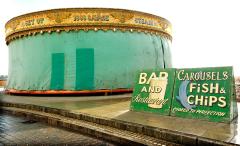ENGLAND: THE OTHER WITHIN
Analysing the English Collections at the Pitt Rivers Museum
Calendar related artefacts
St Giles Fair
Alison Petch
Researcher, 'The Other Within'
St Giles Fair is held on St Giles a street in the centre of Oxford every year on the Monday and Tuesday following the first Sunday after St Giles Day (which is 1 September). It is rather an unusual English fair because it is held in the middle of a city on a normal street rather than in a fairground. It brings the centre of Oxford to a standstill while it is on, with traffic diverted, lots of extra visitors, noise and excitement.
The Fair is named for the street in Oxford where it occurs, which in turn is named after the church at one end which is dedicated to the saint. Saint Giles (died c 710) was a hermit who became very popular in the 7th century and founded a monastery in St Gilles, in the Camargue. His shrine later became an important pilgrimage centre. He was particularly linked with the patronage of cripples, lepers and nursing mothers.
The Fair evolved from the St Giles' parish wake, first recorded in 1624, which later became known as St Giles' Feast. In the 1780s it was a toy fair which sold cheap and useful goods, but by 1800 it had become a general fair as we know it today with stalls and rides. From the 1830s there were amusements for adults as well, and it became known as a rowdy event, that some people wished to close. By Victorian times the Fair had begun to attract people from cities as far away as Birmingham and Cardiff who arrived on special excursion trains. In 1930 the city corporation (now Oxford City Council) took over control of the fair.
An idea of how exciting the Fair must have been is given in this account the Oxford Chronicle of 24 September 1889:
The stalls extended on the west side from Little Clarendon Street to New-Inn-Hall Street. At the top of St Giles' Blandy's Ghost Illusions formed the attraction. In close proximity was a flying trapeze, which was a novelty. A thick wire was erected about 30 feet high and 40 yards long. To this was attached a handle with wheels, which with slight pressure ran swiftly down the wire. The public were invited to take hold of this handle, throw themselves from the platform, and then experience the peculiar sensation of flying though the air. At the end of the wire was a padded board to prevent injury to the aerialists, and a net underneath in case of a fall. This was well patronized, not by men and boys only, but on Monday by numerous females, who ascended the platform and made the flight quite regardless of the audible comments of the onlookers at their temerity. After a time the proprietor of the trapeze was informed that the journey would not be allowed to be undertaken by females.
Day's menagerie, containing a collection of 500 animals, including lions, tigers, leopards, bears, haenas, pack of wild wolves, ostriches, pelicans, vultures, owls, &c., was filled from morning to night. Amongst the other shows were ... two sparring saloons, the armless wonder (a man born without hands or arms) who performed all kinds of work with his feet, 'The Beauty of Adelaide', a woman of immense size, 'Kasper and Tamara', the mysterious thought readers, Carver's champion shooters (a man firing at apples, plums, &c. on a woman's head), Scott's circus, Anderton's conjuring entertainment, Sidgwick's menagerie and waxworks (including Lorenzo, an American lion tamer), the performing fleas, &c. The roundabouts were numerous, and included the old-fashioned ones turned with a handle to the latest improvements in steam-powered engines... Two steam switchback railways should be included among the novelties. They were largely patronized by old and young, and the proprietors of 'the plant' will carry with them pleasant recollections of the fair...
The Oxford Bible stall was, as usual, erected near St John's and Mr Wheelhouse and Commander Williams courteously received all comers. Tracts were freely distributed, and the Church Army held meetings in St Giles' on both days... The majority of young people, as on previous occasions, amused themselves by brushing each other's faces with feather brushes. In a few cases where these were being roughly used the police deprived the owners of them. The attendance was extremely large on both days.
You can see an image of the Oxford Bible stall at the English Heritage viewfinder.
An account was also given by Beatrice Braithwaite Batty who also lived in the City and donated many objects to the Pitt Rivers Museum:
The land on which the fair is held in College property; and were it not that one knows that the annual rental brings in a large sum to the St John's coffers, it would seem strange enough that it should still be held in 'St Giles', where some of the best houses and best families of the place are located, to whom the uproar and the turmoil of the fair must be a sad nuisance - added to which there is the imminent danger of fire from the numberless lamps, and lanterns, and cooking stoves, fed with highly inflammable oils, appertaining to the vans.
... The 'sea-on-land' cars, with canvas sails full set, and a full complement of joyous, careless riders, were floating round and round with a motion so terribly true to nature that we watched the faces of the occupants, expecting them to turn grey or ashy white! But the steam whistle shrieked, and one set got out only to be replaced by another.
Meanwhile, the braying organ belonging to a merry-go-round kept time with the prancing of wooden steeds and the dash of painted chariots whirling round at a rapid pace, while the riders held on for dear life as they swayed towards the centre to preserve their equilibrium.
Drums and fiddles accompanied the dancers in two or three dancing tents. Almost every show had its drum, organ, brass-band, gong, or instrument of some sort to bray forth its whereabouts; and those which had not were advertised by the stentorian voice of a show-man or show-woman ceaselessly inviting persons to enter and see the show 'about to begin'. And the shows were various and varied indeed! [From Some Oxford Customs (1888) cited in http://www.headington.org.uk/oxon/stgiles/fair/1888_batty.htm]
John Betjeman described it, slightly later in the 1930s, as:
It is about the biggest fair in England. The whole of St Giles' and even Magdalen Street by Elliston and Cavell's right up to and beyond the War Memorial, at the meeting of the Woodstock and Banbury roads, is thick with freak shows, roundabouts, cake-walks, the whip, and the witching waves. Every sort of fairman finds it worth his while to come to St Giles'. Old roundabouts worked by hand that revolve slow enough to suit the very young or the very old, ageing palmists and sinister, alluring houris excite the wonder and the passions of red-faced ploughmen... Beyond St Giles' the University is silent and dark. Even the lights of the multiple stores in the Cornmarket seem feeble... And in the alleys between the booths you can hear people talking with an Oxfordshire accent, a change from the Oxford one. [From An Oxford University Chest (1937) cited in http://www.headington.org.uk/oxon/stgiles/fair/1937_betjeman.htm]
Around the same time R.W. Muncey wrote:
'Probably the greatest feature of the fair are the steam roundabouts of various kinds, which are lit up at night by the brightest of electric lights, and stretch along for some considerable distance above the college in nearly one unbroken line and are usually crowded by numbers of visitors. The steam organs and instruments are continually playing and cause the greater part of the din which drowns every other softer sound. The fair occupies all the open ground between St Giles's Church and the Martyrs' Memorial. There are to be seen a circus, midgets, boxing exhibitions, freaks, people fat and people strong, while swings and sausage stalls occupy a place, together with shooting galleries and cocoa-nut shies. Smaller booths and stalls line the pavement of the street on both sides. Here you can buy toys, crockery and fancy articles of various kinds. [cited in Roud, 2006:288-9]
Note that at a local Headington website you can read an account of the Fair by an insider (someone from one of the showman's families).
Artefacts from the St Giles Fair in the Pitt Rivers Museum's collections
1. Poster advertising the Universal Flea Circus at St Giles Fair in 1953 [1953.9.28]The poster announces the arrival of the Universal Flea Circus 'presenting living trained domestic fleas in harness', .. chariot race, Chinese juggling fleas, dancing girl fleas, a flea air force, a tight rope act and a watch dog flea! The show starred Dare-devil Pete, who rode a bike, and Pierre and Pedro, two fleas that fought a duel with swords. The poster is not personalised for St Giles Fair but obviously used the same poster for all the places it travelled to. The poster had been printed for Mr Rayner seventeen years earlier by Willsons. Willsons were furniture makers who also carved wooden blocks for printing elaborate posters, they became the premier poster printers between the world wars. This poster was donated by Professor John Mavrogordato, who was based in Exeter College. He was a Greek scholar, interested in language, literature, history and folklore. He had been the Koraes Professor of Modern Greek at King's College, London earlier in the twentieth century.
Flea circuses showed fleas attached to miniature carts and other items, lenses were used to help the audience see the show. They were common at fairs and circuses between around 1880 to the 1930s though there was at least one still operating in 1970 in the UK, so this poster is for a relatively late showing. Human fleas that were female were used for the performance and had to be trained. They had to be taught not to jump (their natural movement). According to wikipedia this was often achieved by keeping them in a container with a lid. Once harnessed up the fleas would remain like that for life, their strong legs apparently making them able to move items significantly larger than themselves.
2. Friction toys from the fairground
These toys work on the principle described in the wikipedia entry for friction drums:
A friction drum is a percussion instrument consisting of a single membrane stretched over a sound box, whose sound is produced by the player causing the membrane to vibrate by friction. The sound box may be a pot or jug or some open-ended hollow object. To produce the friction, the membrane may be directly rubbed with the fingers or through the use of a cloth, or a stick or cord which is attached to the centre of the membrane and then rubbed or moved with a hand, sponge or cloth, generally wet. The membrane may be depressed with the thumb while playing to vary the pitch.
a. Cardboard toy, worked on the principle of a friction drum. [1952.2.82] It was designed to imitate the sound of a clucking hen by rubbing the hand on the string. Bought at St. Giles' Fair, Oxford, on September 3 1951 by Walter Charles Brice who donated the toy to the museum. This is a typical fairground toy, made to annoy listeners and delight children!
b. Friction drum in the shape of a toy chicken [1985.33.2]
Hélène La Rue, who was the Curator of the music collections at the Museum as well as co-director of this research project, donated an object she had obtained at St Giles Fair in 1985. It was a friction drum made from a toy plastic chicken clipped on to a plastic cup. A string passes through a hole in the base of the cup, and is tied to a small stick on the inside. It had been made in Spain. It is very similar to the last object, but was obtained over thirty years later.
3. Other noice-maker toys obtained at the Fair
a. Toy squeaker
Toy squeaker with bladder and simple clarinet valve, [1933.8.8] obtained by Estella Canziani in 1931 and donated in 1933. Canziani was born in 1887, and was of Italian descent. She worked as an artist and writer and was very interested in folklore and a friend of Beatrice Blackwood, who worked in the Museum. She died in 1964.
b. Wheel rasp
Henry Balfour purchased this musical wheel-rasp at the Fair in 1900 and donated it to the museum four years later. [1904.5.6] Balfour described it as a 'miniature form of the old Watchman's rattle, a rectangular flat piece of wood, 4 5/8" x 1 3/4" with deep notch at one end in which lies a notched wheel fixed to an axe handle, one end of a springy tongue of wood lies against this so that when the instrument is whirling round upon the handle, the tongue strikes rapidly the teeth of the wheel making a jarring sound'.
Further reading
http://www.headington.org.uk/oxon/stgiles/fair/
http://www.st-giles-church.org/saint_giles_-_the_man.htm
http://www.oxford.gov.uk/news/st-giles-fair.cfm
http://viewfinder.english-heritage.org.uk/story/intro.aspx?storyUid=16
http://www.willsons.com/companyhistory.html
http://en.wikipedia.org/wiki/Flea_circus
Steve Roud. 2006 'The English Year: A month-by-month guide to the nation's customs and festivals, from May Day to Mischief Night' London: Penguin Books
You can see the photographs that Henry Taunt took of St Giles Fair at the end of the nineteenth century/ start of the twentieth century at English Heritage's record for Henry Taunt's photo, Henry Taunt took a lifelong interest in the fair and took lots of photographs of it.
To get an idea of what St Giles Fair is like today:
Link to Panaromic views of the St Giles Fair in 2003 and 2004.
and St Giles Fair Night panormaic
Andy Clark of the Flea Circus Research Library [http://www.fleacircus.co.uk] suggests the following further reading:
http://www.pstalker.com/echo/f_36e.html
http://www.headington.org.uk/oxon/stgiles/fair/1889_chronicle.htm
http://archiver.rootsweb.ancestry.com/th/read/OXFORDSHIRE/1999-09/0936534217
http://www.archive.org/stream/oxfordlife012542mbp/oxfordlife012542mbp_djvu.txt



